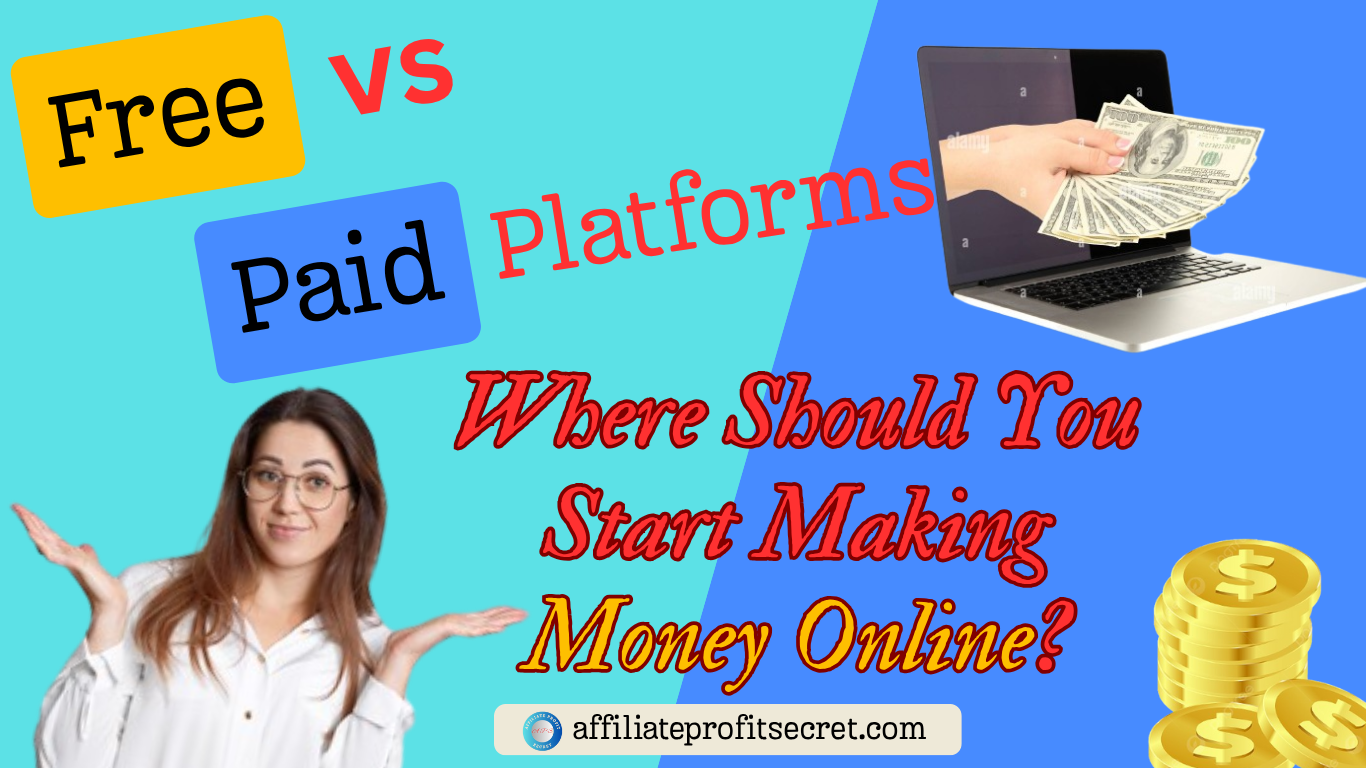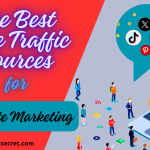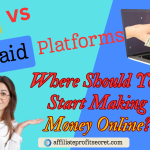Welcome to my article on “Free vs Paid Platforms: Where Should You Start Making Money Online?” In today’s digital age, making money online is no longer a mysterious side quest reserved for tech geniuses or social media influencers with suspiciously perfect morning routines. Whether you’re looking to escape your 9-to-5, monetize a hobby, or just fund your ever-growing caffeine addiction, the internet has a buffet of income opportunities. But here’s the million-dollar (or maybe $10?) question: should you start with a free platform or cough up some cash for a paid one?
In this article, we’re going to break down the differences between free and paid platforms for making money online, weigh the pros and cons, and help you figure out which path makes the most sense for your goals. Whether you’re a broke college student with big dreams or a seasoned side hustler ready to scale, this guide will give you the clarity (and maybe a few laughs) you need to choose wisely. Spoiler alert: there’s no one-size-fits-all answer, but by the end, you’ll be one step closer to turning your Wi-Fi into a paycheck.
My Best Recommended & Proven Way to Make $100-$300 Daily – Watch This FREE Video to START >>>

Understanding the Difference Between Free and Paid Platforms
Before you dive headfirst into the money-making jungle of the internet, you need to understand the lay of the land. And by “land,” we mean platforms—specifically the free ones that cost zero dollars and the paid ones that might make your wallet flinch a little.
Free platforms are like open mic nights—anyone can join, the barrier to entry is low, and sometimes you have to shout to be heard. They’re perfect for testing ideas, building a portfolio, or figuring out if your side hustle has legs. Platforms like Fiverr, Medium, YouTube, and Gumroad (free tier) let you start with zero investment—just your skills, creativity, and maybe a working internet connection that doesn’t drop every 10 minutes.
On the flip side, paid platforms are more like VIP clubs. You pay to get in, but you usually get better tools, more exposure, and fewer people wearing metaphorical flip-flops. Think Shopify, Teachable Pro, or Upwork Plus—these platforms come with upgraded features like advanced analytics, higher visibility, better support, and sometimes even the illusion that you really have your life together.
Here’s the thing: neither is better across the board. Free platforms are great for dipping your toes in the water without risking your rent money. Paid platforms, though, are ideal when you’re ready to treat your online gig like an actual business instead of a weekend fling.
So the big question is—are you looking for a casual relationship with online income, or are you ready to put a ring on it?
Pros and Cons of Starting with Free Platforms
Let’s face it—“free” is a magical word. It’s the siren song that lures us into signing up for software, subscriptions, and trials we absolutely intend to cancel before the billing date (but never do). When it comes to making money online, free platforms offer that same irresistible appeal. But just like unlimited breadsticks, they come with their own set of ups and downs.
My Best Recommended & Proven Way to Make $100-$300 Daily – Watch This FREE Video to START >>>
🟢 The Pros:
- Zero Financial Risk
Starting with a free platform means you can test the waters without betting your lunch money. If things don’t work out, at least you didn’t go broke trying. - Great for Beginners
You don’t need a business plan, a logo, or a 5-year vision board. Just show up, create something, and start learning by doing. - Experimentation-Friendly
Not sure if you want to be a writer, designer, voice actor, or digital dog psychic? Try them all. Free platforms let you explore without commitment (kind of like speed dating for side hustles).
🔴 The Cons:
- Limited Features and Visibility
You might be one of 10,000 freelancers offering the same service on a platform where the algorithm loves veterans. Getting noticed? Harder than finding a clean spoon in a shared kitchen. - Lack of Professional Tools
Free plans often skip the good stuff—analytics, branding options, custom domains. You’ll make do with the digital equivalent of duct tape and optimism. - Platform Control
When you don’t pay, you play by their rules. That means fewer customization options and a higher risk of changes that affect your business (hello, random algorithm updates).
Bottom line? Free platforms are perfect for starting—but eventually, you may outgrow them faster than your first quarantine sourdough starter.
When Paid Platforms Are Worth the Investment
Let’s talk about paid platforms—the ones that make your credit card sweat just a little. At first glance, paying for something you can get (sort of) for free might feel like splurging on avocado toast when you already have bread and butter at home. But here’s the thing: sometimes, that extra guac is worth it.
When it comes to making money online paid platforms shine when you’re ready to get serious—like switching from dating apps to a joint Netflix account. These platforms typically come loaded with perks: better visibility, customizable branding, advanced analytics, priority support, and fewer restrictions that make you want to throw your laptop out the window.
When is it worth shelling out?
- You’ve validated your idea.
If you’ve already made some money using free tools and you’re ready to level up, paid platforms can help you scale without reinventing the wheel every day. - You want to build a brand.
Platforms like Shopify, Teachable, or Podia give you full control over how you look, feel, and function online. Say goodbye to that clunky Fiverr profile that screams “I made this in a rush at 2 a.m.” - You need advanced tools.
Scheduling tools, sales funnels, SEO features, CRM integrations—these aren’t just fancy acronyms. They’re the grown-up tools that help you run an efficient, professional online business. - You want to attract higher-paying clients.
Premium platforms often filter out the bargain-hunters, leaving you with clients who respect your time and your price tag.
Sure, it’s an investment. But if spending $29/month can help you earn $500 more? That’s not a cost—it’s strategy. Just skip one fancy coffee a week and you’re covered (we said skip, not quit—let’s not get crazy).
Best Free and Paid Platforms for Different Niches
Not all online income streams wear the same uniform. What works for a freelance designer might be a terrible fit for an aspiring online tutor—or a guy trying to sell handmade squirrel-sized sweaters (hey, no judgment). The key is finding the right platform for your niche, whether you’re going in free or going in fancy.
My Best Recommended & Proven Way to Make $100-$300 Daily – Watch This FREE Video to START >>>
Let’s break it down:
🧑💻 Freelancing
- Free: Fiverr, Freelancer (basic tier) – Good for building a portfolio and surviving on five-dollar gigs until you level up.
- Paid: Upwork Plus, Toptal – Paid options give you more bids, access to higher-quality jobs, and slightly fewer clients who want the moon for $20.
🛒 E-Commerce
- Free: Gumroad (basic), Big Cartel (free tier) – Simple, fast setups. Great if you’re just testing the market with digital goods or handcrafted llama earrings.
- Paid: Shopify, Squarespace Commerce – Professional storefronts, built-in tools, and SEO that doesn’t require wizard-level skills.
✍️ Content Creation / Writing
- Free: Medium, Substack (free) – Publish your thoughts, build an audience, and earn a few cents per 1,000 claps (or emails).
- Paid: Ghost.org, Substack Pro – For serious writers ready to monetize content with subscriptions, branding, and control over their mailing list.
🎓 Online Teaching
- Free: YouTube, Skillshare (creator tier) – Share your knowledge, grow organically, and compete with 10,000 people teaching the same Photoshop trick.
- Paid: Teachable, Kajabi – Your own branded academy, premium pricing, and no more ads about VPNs in your videos.
No matter your niche, start where you are—with what you’ve got. Free tools can take you far, but when it’s time to grow, investing in the right platform can be like going from flip phone to smartphone: same purpose, way more power.
Which Should You Choose? (Decision-Making Framework)
Alright, decision time. You’ve read the pros, the cons , and maybe even Googled “How to make $1,000 online by tomorrow” somewhere in between. But now you’re faced with the classic crossroads: Should you start with a free platform or invest in a paid one ?
Here’s a little sanity-saving framework to help you decide—no magic 8-ball required.
✅ Choose a Free Platform if:
- You’re just starting and have more curiosity than capital.
- You’re still exploring your niche (no shame in being a side hustle flirt).
- You want to test an idea before you commit—think “try before you buy” but for online income.
- You have more time than money and are willing to hustle harder for visibility.
💳 Go with a Paid Platform if:
- You’ve validated your offer and know there’s demand.
- You want to scale up fast, automate more, or look ultra-professional.
- You’re tired of platform limitations and just want all the tools.
- You’re treating this like a business, not a “maybe someday” hobby.
Still not sure? Think of it like this:
Free is training wheels. Paid is the upgrade to a full-blown mountain bike. You don’t need it to start—but if you’re planning a long ride, it’ll make the journey a whole lot smoother (and faster).
And hey, there’s no rule saying you can’t use both. Many successful creators start with free tools, build an audience, and then invest in the premium stuff. So choose the path that matches where you are now—not where you think you should be.
Just don’t get stuck in “research paralysis.” Action beats perfection—especially online.
Conclusion
So, here we are. You’ve officially earned your honorary degree in Online Money-Making Platformology (not accredited, but very prestigious in certain internet circles). We’ve covered the free stuff, the paid stuff, and everything in between—kind of like comparing ramen noodles to gourmet pasta. Both will fill you up; it just depends on your taste, goals, and budget.
My Best Recommended & Proven Way to Make $100-$300 Daily – Watch This FREE Video to START >>>
The truth is, there’s no one-size-fits-all answer here—and that’s the beauty of the internet. You can start small, learn as you go, and grow into something bigger when the timing (and income) feels right. Free platforms are an excellent launchpad, especially if you’re just testing the waters or still figuring out if that Etsy store selling cactus-themed bookmarks is your destiny. Paid platforms, on the other hand, are like jet fuel—perfect for when you’ve got momentum and you’re ready to fly.
Here’s the golden nugget: You don’t need to get it perfect—you just need to get started. Whether it’s free, paid, or somewhere in between, the key is taking action, learning from it, and adjusting as you go. Online success isn’t a straight road—it’s more like a winding trail with coffee breaks, side quests, and occasional imposter syndrome.
So pick your platform, start creating, and remember: even the biggest digital empires started with a single click (and probably a lot of Googling). You’ve got this.
And if all else fails, you can always write a blog post about how confusing it all is. Trust me, it works.
Thanks a lot for reading my article on “Free vs Paid Platforms: Where Should You Start Making Money Online?″ till the end. Hope you’ve helped. See you with another article.










